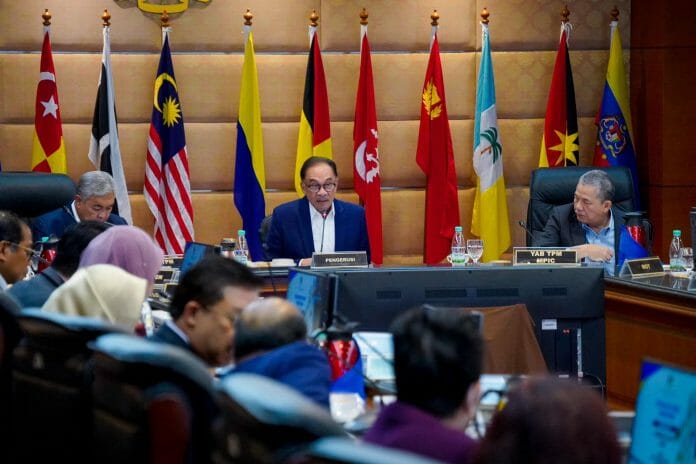
Published by BusinessToday & AstroAwani, image by BusinessToday.
In the re-presented Budget 2023, Prime Minister Anwar Ibrahim who’s also the Finance Minister proposed the introduction of capital gains tax (CGT) on unlisted shares of private limited companies.
Although seen to be modest by proponents of the policy, it’s definitively a step in the right direction and could well provide the base/basis for an eventual expansion at an unspecified later stage.
It can’t be emphasised strongly enough that CGT should be seen as a crucial component in the widening of the nation’s tax base.
In general, there’s bias against the imposition/implementation of CGT by policymakers in Malaysia.
There’s the “phobia” and bugbear that CGT will deter and scare off investment, domestically and abroad, as embodied by capital outflows from the stock market/exchange alongside the concomitant worry of sluggish or lacklustre performance in relation to intra-day trading volume.
Obviously, the spectre of a slacking and laggard Bursa Malaysia as assessed by the Kuala Lumpur Composite Index (KLCI) is that it’ll come back to haunt policy-makers – with damage to our reputation as a favoured/favourite investment hub (as a so-called “emerging market/EM”) for hot money which we’ll never be able to recover from.
But is CGT really a bad policy in the first place?
So that, it’s in a sense only sort of very cautiously or even grudgingly imposed as part of the Malaysia Madani redistribution and debt management agenda?
Let’s take a brief look at how CGT is implemented in other countries first.
In the US, President Biden is proposing to raise the top CGT from 20% to 39.6% (plus 5% Net Investment Income Tax/NIIT which is a surtax or additional tax) as declared in his recent presentation of Budget 2024 on March 9 – which would be the highest in the OECD (Organisation for Economic and Development Cooperation). CGT there is imposed according to or pegged to income.
For example, for 2023, 15% is charged for a single whose income is between USD44,625 to USD492,300.
In addition, this follows the new 1% levy on share repurchases recently signed into law by President Joe Biden that’s meant to put the brakes on buybacks as part of the complex of policy measures under the Inflation Reduction Act (2022).
Both CGT and the share buyback levy represent coordinated and synchronised measures to redistribute wealth from the top one percent and the high-income earners, and also part of the strategic efforts to reduce/narrow the deficit that’s inherited from the pandemic spending under Trump which shot up to USD3.1 trillion in 2020 from USD984 billion in 2019.
Based on Treasury data for fiscal year 2020, revenue derived from CGT was approximately USD121 billion which is close to 10% of the total tax collected (at USD1.3 trillion). The tax on share buyback would raise an estimated USD74 billion over the next ten years, according to preliminary calculations by the Institute on Taxation and Economic Policy
Whilst the British Chancellor’s Spring Budget on March 15, 2023 isn’t expected to see any changes to the CGT structure, clamour for equalisation with income tax is growing. A Labour MP (Richard Burgon) is sponsoring a Private Member’s Bill which in effect is a wealth tax to fund the pay rises for public sector workers – expected to raise GBP17 billion.
CGT receipts in the UK “have increased by over 100% in the past five years and reached a record level of GBP18bn in the last year alone, and a further 18% increase from the previous year” (“Chancellor ‘walking on a knife edge’ with Capital Gains Tax”, Accountancy Age, February 28, 2023).
China’s CGT is 20% across the board – irrespective of type of company, i.e., listed or unlisted, but the former is entitled to a 50% or 100% reduction depending on the length of holding.
India’s CGT is categorised into short-term which is taxed at 15% (or otherwise added to the overall individual income tax/IIT) and long-term which is taxed at 20% for non-equity shares (e.g., derivatives, options) and 10% for equity shares.
In Budget 2023, the government decided that “the surcharge on long-term [CGT] on equity investments will be up to 15 per cent, while [non-equity CGT] were subjected to a graded surcharge of up to 37 per cent” (“New roadmap likely for capital gains taxation in Budget 2023-24”, Business Today/India, November 22, 2022).
Japan’s CGT is imposed at a total rate of 20.315% (15.315% for national revenue and 5% local tax), according to PricewaterhouseCoopers (2023). The current policy debate is whether to raise the rate even higher (to boost defence spending in the context of regional threat).
Closer to home, Singapore applies a kind of “conditional” CGT whereby according to the Inland Revenue Authority of Singapore (IRAS), the gains are considered income of a trade or business. In other words, CGT is re-interpreted as applying only if strictly satisfies the specific criteria of “income” and isn’t merely a “gain” (i.e., considered there as an occasional addition to income which is regular) – which is also the case here in Malaysia.
Given the above survey, we should be already considering moving beyond looking at imposing CGT on unlisted shares to listed companies.
One of the ways to make use of the CGT is to conceptualise it as a strategic fiscal policy lever – in coordination and sychronisation with monetary policy (and not just as part of a widened tax base).
Firstly, CGT isn’t just a source of revenue but critically also a fiscal anchor for currency stability (which comes under the purview of monetary policy of Bank Negara).
In other words, CGT is a (albeit mild) form of capital control – which can be deployed to calibrate the outflow of funds.
Recall the dual-policy measures at the height of the Asian Financial Crisis/AFC (1997/97), namely the pegging of the RM to the USD (RM3.80) alongside selective capital controls. Except that this time around, CGT represents a much milder and weaker version and combining both into a single policy instrument under “ordinary”/standard situations.
In our context, the CGT should be made adjustable or variable, i.e., it moves up and down in coordination with monetary policy. For example, if the overnight policy rate (OPR) is hiked successively, then the CGT should correspondingly be lowered from the current rate.
For non-residents, CGT would be implemented by way of a withholding tax (i.e., amount withheld by the party making payment or payer on income earned/gain by a non-resident or payee and paid to the Inland Revenue Board of Malaysia/LHDN).
Secondly, revenue collected from CGT can go towards investing in food security and help reduce the balance of payments (BOP) deficit in our food imports (whereby in 2021, the total bill came to RM78 billion). In that sense, we can regard CGT as a form of a semi-hypothecated tax.
At the same time, CGT revenue can also go towards promoting the transition to a low carbon economy via green and renewable energy and contribute to the economy meeting its net zero greenhouse gas (GHG) emissions commitment by 2050 by, e.g., promoting cooperation between brown and green energy industries (see EMIR Research article, “Spearheading renewable energy development in Malaysia”, March 6, 2023).
Instead of dividends, earnings could be (re)invested in the shift like in joint-ventures (JVs) between brown and green energy (sub-)sectors. The profits could be distributed and, therefore, enjoy exemption outside of the CGT structure.
Also, carbon credits and sequestration (nature-based solutions/NBS) can be used and should be allowed to offset any CGT (where there’re no JVs, for example).
CGT should be levied on bonds (short-term, i.e., Malaysian Treasury Bills/MTBs and long-term, i.e., Malaysian Government Securities/MGS and Government Investment Issues/GII) and other debt securities encompassing non-resident investors/buyers also, as part of the strategic fiscal policy lever (in coordination and synchronisation with monetary policy). Again, a withholding tax would apply to non-residents.
As for the mechanics of threshold and holding period, CGT could be, e.g., targeted and imposed on dividends of shares that’s RM1 million and above (see EMIR Research article, “Budget 2022 & 12MP – debt ceiling, windfall & capital gains taxes”, October 13, 2021). These would mainly affect the majority shareholders and owners of the companies concerned (including non-listed ones). Hence, this will serve to exempt the minority shareholders in listed companies, some of whom are retirees.
It also means that CGT doesn’t affect and discourage (intra-day) trading volume and subscription.
As CGT takes into account the time-period for holding on to the shares, it’s also a potential tool for stabilising outflow of funds as in pre-empting capital flight.
To promote domestic direct investment (DDI) in the form of e.g., gross fixed capital formation (GFCF) as measured by digital adoption/automation and pre-empt share buyback, we should impose a digital adoption/automation levy – to also reduce our reliance/dependency on foreign labour.
To further assuage anxieties (in addition to being adjustable/variable), CGT (especially for listed companies) should be subject to periodic review (e.g., once every two years).
And the EPF should be the one institution exempted from CGT (see EMIR Research article, “Budget 2022 – taxation from the perspective of a simplified stock-flow analysis”, October 25, 2021).
In terms of categories of activities, futures and forwards contracts (under Bursa Malaysia Derivatives/BMD) should be exempted as both our exporters and importers rely on these to hedge against currency fluctuations.
As for foreigners, we can impose certain requirements for foreign speculators (i.e., through the Chicago Mercantile Exchange/CME trading platform).
One of which is the condition that there must be physical purchases of stocks (the underlying assets), e.g., crude palm kernel oil (CPKO) which can also be used to make chicken feed (food security). In turn, these underlying assets must be sold back to local buyers within a specified time-period, i.e., an additional contract that can’t be longer than three months (see EMIR Research article, “Empowering the rural economy on the road to self-sufficiency”, July 2, 2022).
As for private equity (PE)/venture capitalists (VC), investors (especially in relation to Bursa), they’re already allowed to claim exemption so long that the holding period is up to two years and up to RM500,000 per year.
Beyond that, it’s recommended that part of the shares (e.g., up to 70% of the maximum 30% of the issued shared capital of the investee company) be allowed to convert into a loan stock/debt security under a hybrid structure whereby (the interest is) either exempted from tax which is the pre-existing policy or attract a lower rate – in order to allay any concerns.
Finally, CGT by/in itself can be conceptualised and deployed to expand the tax base, i.e., as fiscal “gateway”/portal to other taxes/sub-taxes, e.g., levies and surtaxes as well as inter-temporal liquidity preference (e.g., from long-term like bonds to short-term portfolios like shares/equity and vice-versa) with implications on inflation and price stability, and as affected by the OPR.
Jason Loh Seong Wei is Head of Social, Law & Human Rights at EMIR Research, an independent think tank focussed on strategic policy recommendations based on rigorous research

